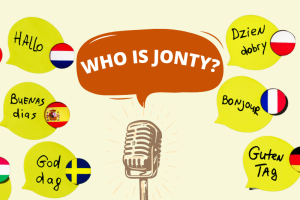Fortunately, there are organizations that study language learning and have broken the concept of fluency into distinct categories. These categories help you use your desired level of proficiency as a basis for estimating your time commitment.
Let’s look at five time-estimating resources: Pimsleur, FSI, CEFR, the British Council, and finally, mine.
Pimsleur
Paul Pimsleur was an applied linguist who developed the Pimsleur language learning system, and his name is widely known in both academic and popular culture.
By his estimates, a person who is willing to skip any efforts to speak or write a language can learn to read material related to their line of work in 100 to 150 hours.
A person who desires what Pimsleur called “balanced competence” could acquire “reasonable mastery” by studying six hours per week for two years.

“Educated mastery,” by which Pimsleur meant the ability to understand most people, read nearly anything without the assistance of a dictionary, and write with some semblance of style, would require at least a year and a half. However, at least a year of that time would be spent in total immersion, living in a country where the language is spoken almost exclusively.
Pimsleur’s estimates may seem daunting, but it’s worth noting that he died in 1976. Language learning systems have come a long way since then, so it would be reasonable to assume that his estimates are somewhat high for the modern language learner.
The Foreign Service Institute (FSI)
The FSI is an established government organization in the United States with a history dating back to 1947. It has continued to research language learning and has developed trainings that are intended for U.S. government foreign affairs professionals.
FSI provides estimates for the amount of time it takes to reach their classifications of language fluency using FSI learning. The FSI’s estimates are for the average number of hours for a native English speaker to achieve “Professional Working Proficiency” in a given language.
- Elementary proficiency: The person is able to satisfy routine travel needs and minimum courtesy requirements.
- Limited working proficiency: The person is able to satisfy routine social demands and limited work requirements.
- Minimum professional proficiency: The person can speak the language with sufficient structural accuracy and vocabulary to participate effectively in most formal and informal conversations on practical, social, and professional topics.
- Full professional proficiency: The person uses the language fluently and accurately on all levels normally pertinent to professional needs.
- Native/Bilingual proficiency: The person has speaking proficiency equivalent to that of an educated native speaker.
Levels one and five are easy to understand and apply to any language student’s long-term learning plan. But the others relate more specifically to the professional world, and may not work for everyone.
Overall, the FSI ratings may be of more utility for a person planning a career in international relations or business.
Languages Ranked by Difficulty
In addition to categories for describing language competency, the FSI has also created a system that places languages into five categories ranked by difficulty.
The specific purpose of these categories is to aid in estimating how long it will take a native English speaker to learn a particular language. Difficulty is defined by a language’s similarity to English, with consideration given to both linguistics and culture.
Category I languages, which the FSI describes as closely related to English, include Afrikaans, Danish, Dutch, French, Italian, Norwegian, Portuguese, Romanian, Spanish, and Swedish. If the FSI designations are accurate, these languages would require the least amount of time to learn.
For a person interested in learning a foreign language reasonably well for instrumental purposes, like course credit, one of these languages might be a good choice.
Category II is described as similar to English, and this category only includes German.
Category III, described as languages with differences from English, and Category IV, which are languages with significant differences, include long lists of languages from Eastern Europe, Southeast Asia, Southern Asia, and Africa.

The most difficult languages, in Category V, are Arabic, Cantonese, Mandarin, Japanese, and Korean. According to FSI estimates, these five languages can take as much as four times longer to learn than those in Category I.
Here’s a summary of the FSI’s time estimates to reach “Professional Working Proficiency”:
Category I Languages |
Approximately 600 – 750 hours |
Category II Languages |
Approximately 900 hours |
Category III Languages |
Approximately 1,100 hours |
Category IV Languages |
Approximately 2,200 hours |
Caveats
Like the Pimsleur estimates, the FSI estimates come with caveats. The most glaring of these is the method by which FSI courses are conducted. FSI students are taught in classrooms with textbooks, and immersion in a community of native speakers isn’t part of the curriculum.
Additionally, the courses are conducted six hours per day, five days per week. It’s a language-intensive program that most language learners don’t have the capacity or time to dedicate, so the FSI’s estimates are more for professionals, such as diplomats, who are learning the language for high-level professional purposes.
Another caveat isn’t taking into consideration the breadth of a human’s ability to focus. It’s limited, and while limits vary among individuals, very few people can effectively engage in learning a single topic for six hours a day.
It’s very likely that many of the training hours were wasted due to inattention or burnout.

For my own part, I think it’s possible to achieve a very strong level of fluency in far less time, so long as the language learner is using the materials and methods right for them.
One final caveat when it comes to the FSI is that it’s not entirely clear what “Professional Working Proficiency” is. The reason for this is two-fold: firstly, the FSI has never publicly defined what this means.
Secondly, even if they did, this definition would vary dramatically based on what one’s profession is; a diplomat will require very different vocabulary and grammatical skills than a poet or a chemical engineer.
Although the FSI is well-established, its research and findings have really only taken into consideration a small group of people i.e. diplomats and other government professionals, and not the general public.
Common European Framework of Reference (CEFR)
The Common European Framework of Reference for Languages (CEFR) provides some insights into how long it takes to learn a language. The CEFR is an international standard for describing language ability. It describes language ability on a six-point scale, from A1 for beginners, up to C2 for those who have mastered a language.
These levels are often referenced for job requirements and are used when converting standardized test scores. For example, if someone scored a 7.0 on the IELTS, it would be converted to a C1 level for CEFR.

Caveats
As with all estimations for language fluency, there are some caveats. First, because CEFR is based in Europe, these time estimates assume European language learners.
It’s important to keep in mind that on a daily basis, the typical European is exposed to many more languages than the typical American.
A Dutch-speaking Belgian, for example, would likely achieve fluency in French very quickly because 40 percent of Belgians speak French as their first language.
Another caveat is that the CEFR estimates don’t consider how easy or difficult a given language is for a European language learner. Common sense would dictate that Spanish is a lot easier for a native Portuguese speaker to learn than Arabic or Chinese.
Here’s how they define their levels.
CEFR Fluency
In practical terms, a CEFR B2 level of fluency is a strong level of proficiency; at this level of fluency, one can easily:
- Understand the main ideas of complex text on both concrete and abstract topics, including technical discussions in their field of specialization.
- Engage with a degree of comfort and spontaneity that makes regular interaction with native speakers quite possible without strain for either part.
- Produce clear, detailed text on a wide range of subjects and explain a viewpoint on a topical issue giving the advantages and disadvantages of various options.
Learners at this stage of study typically command a working vocabulary of 4,000 – 5,000-word families.
The table below shows the amount of study time per day (on a 5-day schedule) necessary to achieve various levels of CEFR fluency.
CEFR Fluency Level |
Hours Required |
Time needed for studies per week (per day) assuming study 5 days per week |
A1 |
80 – 100 hours |
Target: 25 min/day (Range: 19 – 24) |
A2 |
180 – 200 hours |
Target: 45 min/day (Range: 43 – 48) |
B1 |
350 – 400 hours |
Target: 90 min/day (Range: 84 – 96) |
B2 |
500 – 600 hours |
Target: 120 min/day (Range: 120 – 144) |
Note: These time estimates are additive. In other words, an A1 level of fluency requires 80 – 100 hours. An A2 level of fluency would then require an additional 180 – 200 hours, etc.
Time Caveats
The table above demonstrates an unspoken truth about language learning. True fluency in a language takes time. In the beginning, the amount of time necessary to achieve low levels of fluency isn’t such a great burden. But as the target level of fluency expands, so does the daily time required to achieve that level of fluency.
The expanding nature of time necessary to achieve higher levels of fluency also helps to explain the “intermediate plateau” that so many language learners lament.
It should be stressed that the time estimates above are illustrative. One might allocate 45 minutes per day from the beginning and achieve A1 fluency in half the time.
Alternatively, one might allocate those same 45 minutes per day and chip away at B2 fluency over a three-year period (after having achieved B1 fluency in previous years).
CEFR via the British Council
The British Council is an international organization devoted to cultural and educational opportunities. They offer time estimates for reaching CEFR levels using their learning programs.
A1 |
No estimate is given since A1 is defined as the starting point |
A2 |
Approximately 180 – 200 hours |
B1 |
Approximately 350 – 400 hours |
B2 |
Approximately 500 – 600 hours |
C1 |
Approximately 700 – 800 hours |
C2 |
Approximately 1,000 – 1,200 hours |
Caveats
Since these estimations are tied to CEFR, they come with the same caveats. The time estimations assume a learner whose native language is European and that they may have natural daily exposure to the target language.
The British Council estimates also don’t take into consideration the relationship between the learner’s native language and target language.
As previously mentioned, it would most likely take a shorter time for a native Spanish speaker to learn Portuguese due to the similarities in the languages than a speaker of Korean.
A Polyglot’s Experience

That said, with a huge grain of salt, I think it’s fair to assume that it could take somewhere between 500 – 1,000 hours for a language learner to feel very comfortable with most languages. When I say “feel very comfortable,” I mean that you’d:
- Feel comfortable speaking with native speakers
- Understand their speech at their normal speed
- Be able to speak freely and fluidly without consciously translating words in your mind
- Be able to read and write the language without too much difficulty
To be clear, you absolutely wouldn’t be able to use the language as freely as a native speaker. But accent aside, you might be mistaken as a fluent speaker if you stay within a narrow band of topics.
This has been my own experience speaking several of the languages I know. It also seems to be the case with my wife, for whom English is her fourth or fifth language.
Many factors dictate how long it takes to achieve mastery of a foreign language. Many of them, like innate ability, haven’t been mentioned here.
However, some general information and a bit of self-understanding make it entirely possible for you to reasonably estimate how much time is necessary to achieve your desired level of fluency in a new language.
True language fluency requires consistent effort and time. While 500 – 1,000 hours may seem like a lot, a typical person could probably invest that level of time over 12 – 18 months, with the right study schedule.
At a minimum, that would only be a commitment of an hour per day. And if that still seems a bit overwhelming, bear in mind that this is what it might take to achieve a certain level of fluency. You may be perfectly happy just getting by with the bare basics, and that takes far less time.
As we’ve discovered, there’s no simple answer to the question of how long it takes to learn a new language. There are far too many variables, including but not limited to:
- How fluency is defined
- Which language is being learned
- How much exposure the language learner previously had to other languages,
- Whether immersion is part of the process
But the information I’ve provided should give you a good grip on approximately how long it will take you to reach your language learning goals.
Break Your Language Learning into Short-Term Goals

Learning a language can be daunting when you see the numbers, such as 500+ hours for learning or a vocabulary of 10,000+ words. However, it is important to remember that learning another language is a long-term project. It helps to break it down into short-term goals.
As author Robert Collier is famously quoted as saying: “Success is the sum of small efforts-repeated day in and day out”. Making small efforts on a daily basis can reap big rewards, so here are some tips to break it all down.
Tips to Get You Started On Your Short-Term Goals
An obvious short-term goal is to decide to learn a certain number of words within a defined period of time (for example, 20 words a week). Over the period of a year, this adds up to 1,000 new words, which is around the learning rate of native speakers of English.
Words per day |
Words per week |
Words per month |
Words per year |
5 |
35 |
140 |
1,680 |
10 |
70 |
280 |
3,360 |
20 |
140 |
560 |
6,720 |
30 |
210 |
840 |
10,080 |
Another short-term goal is to do a certain amount of reading at the right level each week.
In the early stages of language learning, doing a total of somewhere between one to two hours a week each week (around 20 minutes a day) can have very good effects on learning, especially if the material doesn’t contain many unknown words.
If you’re just starting your language-learning journey, read children’s books in your target language. It may seem silly to read children’s stories as an adult, but as a new learner in your target language, you’ll most likely have the vocabulary of a five-year-old.
As your vocabulary and grammar skills strengthen, you can start reading more advanced books meant for young adults and eventually read adult-level books. Other reading materials could be short articles on the internet or magazines.
Similarly, setting regular weekly goals for listening can greatly add to the amount of understandable input. Listening can come from many different mediums, including music and movies.
Watching a YouTube series in your target language could be helpful as well, and even short videos with audio in your target language, such as TikTok, would be useful for pronunciation and learning phrases.

Listening to social media content would be especially useful when learning slang and colloquial terms/phrases that will help you on your path to becoming a fluent speaker.
It may be helpful to keep a brief record of this weekly work, ticking off each week as it’s completed. Some learners like to set the rule that they do some work on learning and using the language every day, even if, on some days, that time only equates to a few minutes.
Some people are motivated by hitting goals and rewarding themselves. For example, you could aim to learn 100 words in one week.
If you do that, you could reward yourself with something like a new piece of clothing or a fancy coffee. Remember, big jobs are completed through many small steps.
Physical Effects of Short-Term Goals

While there are physical limits to how fast we can learn and how well we retain that material, understanding how memory works helps to motivate and inspire us to get the most out of our effort.
As you push forward and continue to study, you gain momentum, knowing that each repetition gives your brain another opportunity to undergo the physical changes it needs to provide you with rapid access to new memories.
Imagine your brain forming synapses with each new lesson you understand. Over time, your brain will be a thriving network of knowledge of your target language, with the vocabulary easily linked to grammar and pronunciation.
One of the best aspects of goals is that you can start at any time, even right now. Yes, RIGHT now. You don’t need to wait for the new year, and you don’t need to wait for the next month.
Even if it’s later in the evening, you can still start your language-learning journey today. There’s still time to learn five words in your target language. Remember that learning anything new is a process of small steps that can be taken at any moment, just one at a time.
Grow Your Vocabulary and Increase Your Fluency through Reading
Oftentimes, fluency is measured based on how well a person can engage in a verbal conversation, and emphasis is put on speaking and pronunciation to showcase fluency.
However, to be able to speak at a fluent level, a learner must have a vocabulary bank to retrieve words from to hold a conversation. That vocabulary bank can be grown in various ways, and one of those is through reading.
Achieve Fluency through a Balanced Approach: Why Only Reading to Fluency Doesn’t Work

Many language institutions have developed frameworks that estimate the amount of time it would take to learn a language at different levels of fluency, such as the CEFR (although the estimates for this institution are mostly based on a European context).
Independent of the CEFR time estimates, language-learning researcher Paul Nation undertook a separate analysis to estimate the time required to achieve various levels of fluency.
Nation sought to explore how much comprehensible input one might need through reading alone in order to acquire various levels of working vocabulary.
In order to map Nation’s framework to the CEFR fluency levels, let’s use the following simplification of CEFR’s levels:
- A1: ~500 vocabulary terms
- A2: ~1,000 vocabulary terms
- B1: ~2,000 – 2,500 vocabulary terms
- B2: ~4,000 – 5,000 vocabulary terms
With this mapping in mind, let’s explore Nation’s research findings below:
1000-word list level |
Amount to read |
Time needed for reading per week (per day) at a reading speed of 150 words per minute |
2nd 1,000 |
200,000 words |
33 minutes (7 minutes per day) |
3rd 1,000 |
300,000 words |
50 minutes (10 minutes per day) |
4th 1,000 |
500,000 words |
1 hour 23 minutes (17 minutes per day) |
5th 1,000 |
1,000,000 words |
2 hours 47 minutes (33 minutes per day) |
6th 1,000 |
1,500,000 words |
4 hours 10 minutes (50 minutes per day) |
7th 1,000 |
2,000,000 words |
5 hours 33 minutes (1 hour 7 minutes per day) |
8th 1,000 |
2,500,000 words |
6 hours 57 minutes (1 hour 23 minutes per day) |
9th 1,000 |
3,000,000 words |
8 hours 20 minutes (1 hour 40 minutes per day) |
Direct comparisons are difficult, for these reasons:
- The CEFR estimates are cumulative at each level of fluency. Whereas Nation’s estimates define how much time is required to acquire a certain vocabulary volume over a single year.
- The CEFR estimates assume time spent across all domains of language learning. Whereas Nation’s estimates focus exclusively on reading.
Nation himself has advocated that a language learning program focused exclusively on reading comprehensible input isn’t a balanced approach.
But all the points above notwithstanding, it’s clear that achieving an A2 level of fluency can be achieved with moderate effort: approximately 260 – 300 hours according to the CEFR, and approximately 30 hours according to Nation’s estimates.
According to the CEFR, a B2 level of fluency would require approximately 1,000 – 1,300 hours of total effort. Nation’s estimate is closer to 180 hours in total.
This may suggest that exposure to comprehensible input through reading can accelerate language acquisition by an order of magnitude.
Equally so, this order of magnitude difference may simply reflect the time necessary to achieve fluency in one domain of language learning (reading) with no effort placed on the other three domains (writing, speaking, and listening).
Which Learners Benefit from an Emphasis on Reading?

It’s important to remember that every language learner is different and has their own strengths and weaknesses. Reading may be a strength for one learner, whereas another learner may pick up a language more quickly through speaking.
Putting an emphasis on reading in order to learn a language may be useful for learners who:
- Easily retain information when it’s presented in written form
- Can read for a fair chunk of time every day (i.e. while taking public transportation to work, have some free time in the morning or evening, have a quiet lunch break where they could read, etc.)
- Have access to reading materials, such as books or magazines, in their target language
It wouldn’t be advised to use any one domain to learn a language, i.e. only reading, writing, listening, or speaking. This will leave major gaps in a language learner’s fluency.
For example, if a learner only obtains their target language through auditory mediums, such as music, video games, or movies, their writing skills in their target language may be abysmal and would hinder them in an educational or professional setting.
If a learner only learns a target language through reading, it may make social interactions awkward or impossible because of the lack of knowledge pertaining to pronunciation.
Each domain of language learning provides benefits and allows the learner to inch closer to the goal of fluency. Utilizing reading, speaking, listening, and writing in at least some capacity would be optimal for language acquisition.







